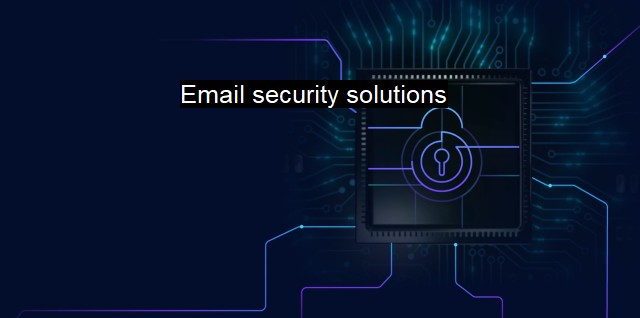What are Email security solutions?
Securing Your Inbox: Protecting Confidential Information with Email Security Solutions for Individuals and Businesses
Email security solutions refer to techniques and methodologies employed to protect email content, accounts, and communication infrastructure from a variety of cybersecurity threats such as phishing, spoofing, malware, and spam. It is essentially a system that combines processes, policies, and technologies to secure both incoming and outgoing emails.Nearly everyone uses email daily, and over half of the global population uses emails actively. This massive user base, along with the prevalent use of email for transmitting sensitive and confidential data, has turned email systems into a prime target for cybercriminals. Thus, reliable and robust email security solutions have become a mandatory aspect of cyber hygiene for individuals, businesses, and even governments.
Cyber threats continue to evolve in their sophistication and frequency, so must the defenses against them. Email security solutions have evolved from simple spam filters to a raft of measures, including multi-factor authentication (MFA), data loss prevention (DLP), encryption, sandboxing, and advanced threat protection engines.
Multi-factor Authentication is a method that requires users to provide multiple evidence or credentials to authenticate their identity for gaining session access. It ensures that even if a user's password is stolen, the hacker will not gain immediate access to the account, as they don't have the additional authentication factor needed to sign in.
Data Loss Prevention is a set of tools that prevent sensitive data from leaving an organization’s system. It analyzes every outgoing email for sensitive data and either blocks the email or warns the sender.
Email encryption is yet another technology within email security solutions. It uses algorithms to scramble the email content making it unreadable to anyone without the decryption key.
Sandboxing is another process where incoming or outgoing emails are diverted to an isolated, secure cloud environment where the attachments are opened or executed. If malicious behavior is detected, the file or email is quarantined, protecting the recipient's endpoint from infection.
Advanced Threat Protection engines employ a host of automated tools that scan incoming emails for potential risks. Depending on the solution, these tools may include artificial intelligence (AI) and machine learning (ML) techniques programmed to detect virus signatures, anomalies, or suspicious behaviors.
For businesses, especially, implementing email security solutions can prove greatly beneficial. It not only reduces the risk of cyberattacks but also ensures the confidentiality, integrity, and availability (the CIA triad) of their data. Shielding their digital communication method, businesses can reinforce their brand trust and prevent potential reputation damage caused by data breaches.
Similarly, antivirus plays a crucial role in email security. Antiviruses are software solutions designed to detect and neutralize threats like viruses, worms, Trojan horses, spyware, adware, and more, before they can cause harm. Antivirus scans the content of every email, its attachments and even embedded links to detect and eliminate these potential threats.
As organizations embrace digital transformation, their workforce increasingly becomes mobile, remote, and even borderless. This shift necessitates regular system updates, new security policies, and more comprehensive security measures. Thus, the industry is witnessing advancements in email security solutions, such as the integration of AI and ML technologies.
Email security solutions are an integral part of cybersecurity as they provide critical defense mechanisms against the constant onslaught of cyber threats, subsequently ensuring data privacy, confidentiality, and protection. As a result, every individual user, organization, institution, and government needs effective email security solutions to safeguard sensitive data being shared through emails, build resilience against cyberattacks, and foster a secure digital environment.

Email security solutions FAQs
What is an email security solution?
An email security solution is a software or service that provides protection against various email-related threats, such as phishing attacks, spam, malware, and other forms of cyber threats. It involves different technologies and approaches to secure email communication and prevent data breaches.Why do businesses need an email security solution?
Businesses need an email security solution to protect their sensitive data and confidential information from cyber threats that target email communication. Email is one of the most common channels used by hackers to launch various attacks, such as email spoofing, spear-phishing, ransomware, and others. An email security solution can help businesses prevent such attacks and ensure the confidentiality, integrity, and availability of their email communication.What features should I look for in an email security solution?
When choosing an email security solution, you should look for features such as anti-spam, anti-phishing, anti-malware, content filtering, email encryption, multi-layered protection, and user training and awareness. The solution should also be easy to deploy, manage, and scale, and integrate with other security solutions to provide comprehensive protection.How can I ensure the effectiveness of an email security solution?
To ensure the effectiveness of an email security solution, you should follow best practices, such as keeping the solution up to date, configuring it properly, conducting regular audits and assessments, monitoring and analyzing email traffic, and providing user training and awareness. You should also have a response plan in place to address any incidents or breaches that may occur despite the security measures in place.| | A | | | B | | | C | | | D | | | E | | | F | | | G | | | H | | | I | | | J | | | K | | | L | | | M | |
| | N | | | O | | | P | | | Q | | | R | | | S | | | T | | | U | | | V | | | W | | | X | | | Y | | | Z | |
| | 1 | | | 2 | | | 3 | | | 4 | | | 7 | | | 8 | | |||||||